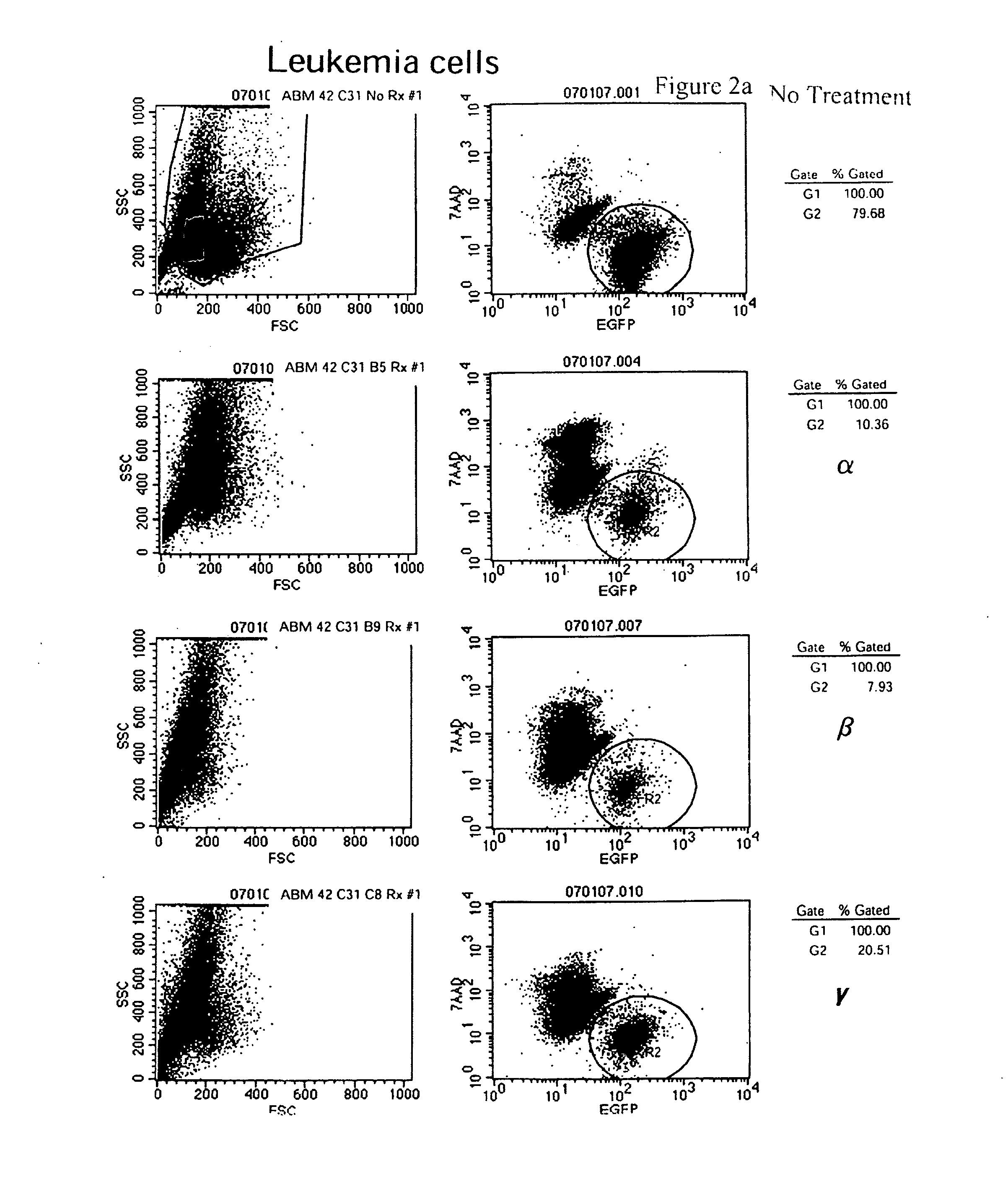Compounds for treating abnormal cellular proliferation
a technology of cellular proliferation and compound, applied in the direction of biocide, tumor/cancer cells, drug compositions, etc., can solve the problems of abnormal cell growth, abnormal cell growth, abnormal cell growth,
- Summary
- Abstract
- Description
- Claims
- Application Information
AI Technical Summary
Benefits of technology
Problems solved by technology
Method used
Image
Examples
example 1
Preparation of Hematopoetic Stem Cell Line and Leukemic Stem Cell Lines
[0221]Normal conditionally immortalized stem cell lines (ctlt-HSC cell lines) are prepared from 5FU treated mice were transduced with retroviruses encoding MYC-ER and Bcl-2 and transferred into lethally irradiated recipient mice (1200 rads). Ten days later, weekly intraperitoneal injections of 1 mg / mouse of 4-hydroxytamoxifen (4-OHT) emulsified in oil are initiated to activate MYC function. Within four weeks, recipients of young transduced stem cells developed tumors. The tumors are harvested from bone marrow, spleen and lymph nodes and cultured in vitro with 4-OHT and a stem cell growth factor cocktail (IL-6, IL-3 and stem cell factor (SCF)). These cell lines are homogenous in phenotype and exhibit the phenotype of long-term hematopoietic stem cells (lt-HSC) that provide all long term reconstitution in mice, and are easily recovered after freezing, retaining their original phenotype. Importantly, these cell line...
example 2
Viability Based Drug Screen
[0222]Leukemic stem cell lines and normal hematopoetic stem cell lines are separately maintained in cultures as described above. For viability assays, the cell lines are passed 24-36 hours prior to use in the assay, in order to test for sensitivity to specific drugs with cells in log-phase growth. Cells are plated in 96-well flat bottom plates (Greiner, Switzerland), at a concentration of 104 cells for the leukemic stem cell lines and normal hematopoietic stem cell lines, or 105 for the primary human fetal cord blood cells. Cells are plated in a final volume of 200 μl containing RPMI-1640 growth medium, supplemented as described above. Cells are either plated in medium alone, or medium containing a drug of interest. All drugs are tested in 11 different concentrations in order to derive sensitivity curves. The individual conditions were set up in triplicate wells, and at least three independent assays are performed to validate a specific observation.
[0223]T...
example 3
[0226]4-Amino-7-[(2R,3S,4S,5R)-3,4-dihydroxy-5-(hydroxymethyl)oxolan-2-yl]-6-hydrazinylpyrrolo[5,4-d]pyrimidine-5-carboxamide, 2-[(2-chloro-4-nitrophenanthridin-6-yl)amino]ethanol, and 5-(anthracen-1-ylmethylidene)-2-sulfanylidene-1,3diazinane-4,6-dione preferentially inhibit murine leukemic stem cell viability vs. normal murine hematopoietic stem cell line. These compounds are screened for the ability to inhibit leukemic stem cell viability but not affect normal hematopoietic stem cells by incubating the compounds with cells using serial two-fold dilutions starting from 10 μM stocks. These compounds preferentially inhibited viability of the leukemic stem cell clone ABM42 C31 but not the normal murine hematopoietic stem cell line “BL / 6 BM” (FIG. 1).
PUM
| Property | Measurement | Unit |
|---|---|---|
| volume | aaaaa | aaaaa |
| time | aaaaa | aaaaa |
| pH | aaaaa | aaaaa |
Abstract
Description
Claims
Application Information
 Login to View More
Login to View More - R&D
- Intellectual Property
- Life Sciences
- Materials
- Tech Scout
- Unparalleled Data Quality
- Higher Quality Content
- 60% Fewer Hallucinations
Browse by: Latest US Patents, China's latest patents, Technical Efficacy Thesaurus, Application Domain, Technology Topic, Popular Technical Reports.
© 2025 PatSnap. All rights reserved.Legal|Privacy policy|Modern Slavery Act Transparency Statement|Sitemap|About US| Contact US: help@patsnap.com



